John Milewski reveals the superb Umarex H&K MP7 break-barrel
Having immensely enjoyed plenty of range time with the Mini Uzi, the Umarex MP7 caught my attention because it is based on a similar spring-powered powerplant and is a very good 1:1 replica of the 4.6 x 30mm calibre Heckler & Koch MP7.
ORIGINS
The MP7 firearm can trace its origins to the late 1980s and a NATO requirement for a Personal Defence Weapon (PDW). The principle being that support personnel, such as drivers and those operating crew served weapons, could be issued a small automatic firearm that was capable of penetrating Soviet body armour and helmets. A 4.6mm cartridge was developed alongside the MP7 because a narrow, light bullet could penetrate deeper than the 9mm round used in pistols. Ironically, the 4.6mm round is only just wider than a .177 pellet in terms of diameter and the Umarex MP7 is made in .177, resulting in a close association between the two pistols.
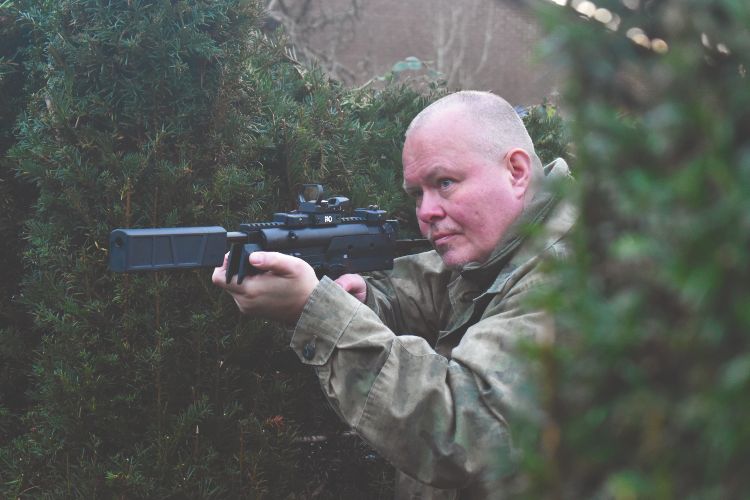 I opted to keep the open sights as back up and rely on a PAO Electro Dot as my primary sighting system.
I opted to keep the open sights as back up and rely on a PAO Electro Dot as my primary sighting system.
An extendable stock, pop-up open sights and an option of fitting an optic, such as a red-dot sight, extends the range of the firearm and the same options also enhance the accuracy of the Umarex, albeit sights are an (essential) optional extra.
COMPARISONS
The overall profile is very close to an original with the exception of a higher bore axis and faux silencer on the Umarex. This is fitted as a cocking aid and makes the MP7 easy to cock because the Umarex is a break-barrel airgun wearing a synthetic MP7 overcoat. Controls, such as the charging handle, bolt and magazine release catches, are all replicated as synthetic mouldings. The Picatinny rails on top of the receiver and sides of the body are real, though, and can be used to mount sights and other accessories, such as lights, lasers, etc.
 The sliding stock offers a choice of two extended positions.
The sliding stock offers a choice of two extended positions.
USING THE EXTENDABLE STOCK
The stock extends just like the original and there are two settings. Neither are ideal for an air rifle, though, because the shortest offers a short 12½ inch reach to pull, whilst the long setting is a little too long at 16¾ inches. I experienced an inordinate amount of vertical wobble on the longer setting, so tended to use the shorter setting for most of my testing. The stock also tended to move out of its longer setting notch between shots, which was a little annoying.
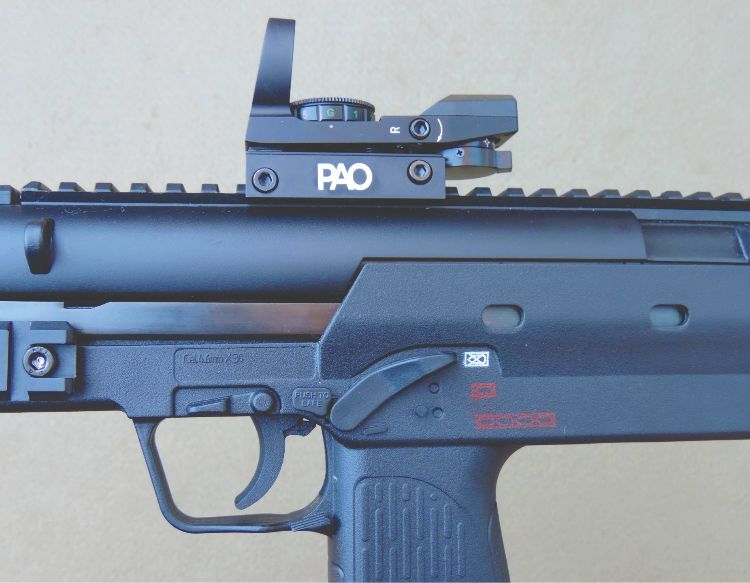 The dummy fire selector can be manipulated if you release the cross-head screw that holds it in place on the right side.
The dummy fire selector can be manipulated if you release the cross-head screw that holds it in place on the right side.
To get the best from the stock, I used it as an aid to a consistent hold rather than bracing up against it conventionally. By not pressing against it at all, the stock guided me toward holding the MP7 consistently for every shot, and this proved to be a successful method for extracting the most accuracy from the design.
Handling is very similar to the Umarex Mini Uzi because both airguns are very similar mechanically and in profile. The MP7 scores slightly higher in a comparison, though, because the vertical pistol grip has smoother and more comfortable contours, which is not a deal breaker on the Uzi, but noticeable during a lengthy range session.
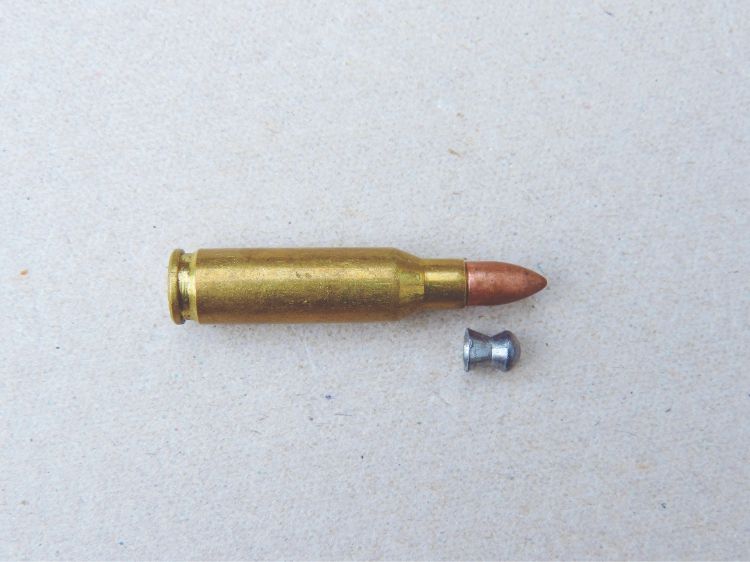 The 4.6mm calibre of the firearm uses a bullet that is fractionally wider than a .177 pellet!
The 4.6mm calibre of the firearm uses a bullet that is fractionally wider than a .177 pellet!
AGGRESSIVE TRIGGER TECHNIQUE
The trigger pull is the same as the Uzi’s in that it is long and creepy. Accepting it is not a match unit, I use an aggressive trigger technique, which works for me and involves smoothly pulling the trigger with greater force than I would usually use for target work. A consistent hold is vital and I probably use a firmer grip than I should just to keep the arm on aim. Think ‘doubleaction revolver trigger’ because the pull feels that long, albeit I’m probably exaggerating just a little.
PERFORMANCE
I obtained original H&K MP7 open sights, which consist of fixed blade and notch pistol sights when folded down and a pop-up aperture and fore sight when raised. The fore sight was nice and broad, which resulted in a very clear sight picture and excellent accuracy, whilst the fixed pistol sights shot high left, but were infinitely usable when the MP7 was shot like a pistol. Once zeroed, pellets landed on top of pellets and I soon realised that the MP7 was made for longer distance shooting than 6 yards, with a power output of almost 4 ft.lbs. I then fitted a PAO Electro Dot Sight and the 33mm wide lens offered a very usable uncluttered sight picture.
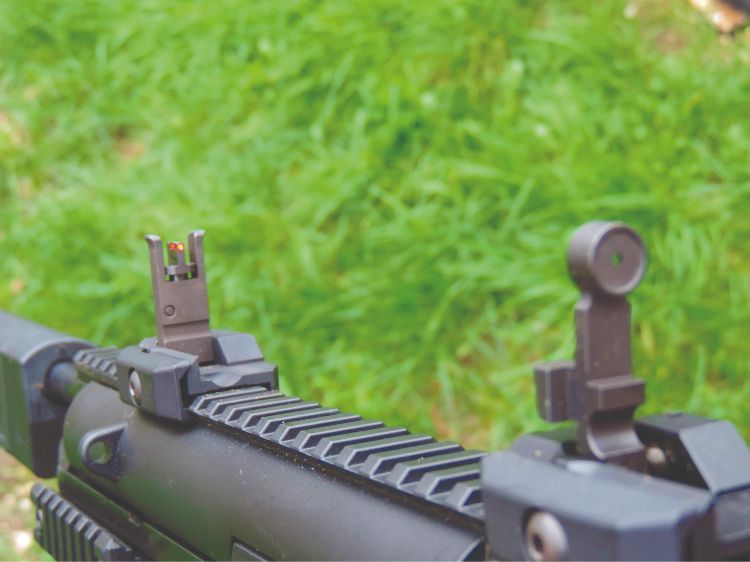 Flip the sights up and extend the stock and you have an aperture-sighted carbine.
Flip the sights up and extend the stock and you have an aperture-sighted carbine.
After extending the range to 15 yards, pellets landed around 1½ inches high and I was able to attain an excellent group on an apple that I placed on top of a tin can, before blasting the latter to pieces. I was also able to connect with a pellet tin end-on at 30 yards on my first attempt by aiming just above the target.
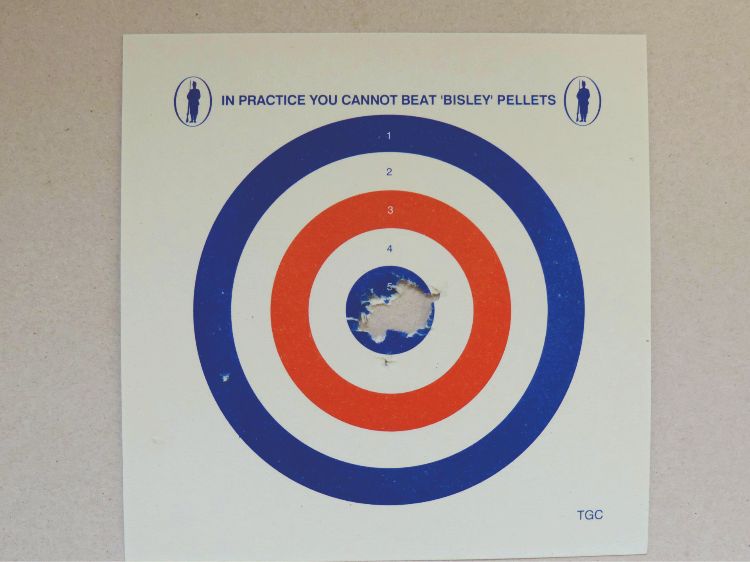 This is an incredibly accurate airgun to use with above average power for a plinking replica as these results at 6 yards from the standing position show.
This is an incredibly accurate airgun to use with above average power for a plinking replica as these results at 6 yards from the standing position show.
Some owners have fitted telescope sights to the MP7 because the accuracy potential is certainly there. However, for me, the attraction of replicas like the MP7 is their resemblance to the firearms they imitate, and I prefer a less cluttered profile. The MP7 certainly provides that when fitted with a quality set of pop-up open sights or a low-profile red dot, and is capable of excellent accuracy, to boot. I bought my example to test and then possibly move on, but I will be hanging on to her for a while yet because the performance is way better than expected.